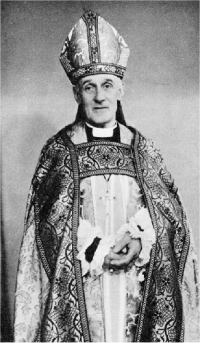Consecration 1940 Successor Robert Stopford In office 1956–1961 | Name Henry Campbell | |
 | ||
Parents Sydney Montgomery Campbell Place of burial Wivelsfield, United Kingdom | ||
Henry Colville Montgomery Campbell (11 October 1887 – 26 December 1970) was a Church of England bishop. He was ordained in 1910 and served as vicar or rector in a number of London parishes before being consecrated as a bishop in 1940, holding, successively, the suffragan bishoprics of Willesden and Kensington and the diocesan bishoprics of Guildford and London until his retirement in 1961.
Contents
Early life and ordained ministry
Montgomery Campbell was the son of the Rev Sydney Montgomery Campbell, who was ordained as an Anglican priest in 1885 and became vicar of St John's, Hammersmith, and later of Midhurst and Banstead. The son was educated at Malvern College and Brasenose College, Oxford. After studying at Wells Theological College he was ordained deacon in December 1910 and priest in 1911. His first appointment was a curacy at Alverstoke. In`1916 he married Joyce Mary, daughter of the Rev Norman Thicknesse, rector of St George's Hanover Square. After distinguished wartime service in which he received the Military Cross for bravery at Gallipoli, he served as vicar of West Hackney (1919–26) and Hornsey (1926–33). In the latter post he ran a centre for the unemployed in a building made available to him by the government. From 1929 to 1933 he also held the post of Rural Dean of Hornsey. In 1933, on Thicknesse's retirement, Montgomery Campbell was appointed to succeed him at St George's.
Episcopal ministry
Montgomery Campbell was ordained to the episcopate as the suffragan Bishop of Willesden in 1940, and translated to be the Bishop of Kensington in 1942. He became a diocesan bishop as Bishop of Guildford in 1949. His diocese was of quite recent creation, having been formed in 1927. The new cathedral by Edward Maufe was under construction, and the pro-cathedral, Holy Trinity Church, in which Montgomery Campbell was enthroned, was the building in which he had been ordained a priest, 38 years earlier. At first, he was doubtful about the need for a new cathedral, but once he had recognised it as a good thing he backed it enthusiastically.
On the retirement of William Wand, Montgomery Campbell became the Bishop of London in 1956, in which position he also became a Privy Councillor. He became known for his wit, which was sometimes cutting. In the 1990s, his bons mots were recalled in the columns of The Times. On Mervyn Stockwood's appointment to the bishopric of Southwark, he commented, "I'm taking steps to have the Thames widened"; and later, when encountering Stockwood who was dressed not in the customary black frock coat and gaiters but in purple cassock and cloak, he greeted him, "Hello, Mervyn, incognito I see." He described Geoffrey Fisher, Archbishop of Canterbury, as "a hard man – he boils his eggs in widows' tears". About to interview an ordinand he said, "Come in, Brown. Take a chair." The young man corrected him: "Fiennes-Brown, my Lord." "Take two chairs" was the reply. Commenting on his predecessors and successors at Guildford he said, "The first Bishop of Guildford went out of his mind, the second had no mind to go out of, then they had me, then a saint, and now they have started all over again." At his enthronement as Bishop of London he banged ceremonially with his crosier on the great West door of St Paul's, which there was some delay in opening. He turned to his chaplain and said, "We've come to the wrong place". When the door was finally opened revealing the aged canons of the cathedral, he commented, "The See gives up its dead".
A modest man, he called himself "one who is no figure in public life and no scholar, but simply and solely a Father in God who goes round the parishes visiting the chaps – the only thing I am any good at". His obituarist in The Times commented that this was an underestimate of Montgomery Campbell's abilities, and that he was "a wise and discerning administrator, who could quickly grasp the essentials of a situation and impart to it his own sure touch. He was at heart a man of prayer and great dedication."
Montgomery Campbell retired in 1961. He died at the age of 83 in Westminster Hospital on 26 December 1970 having contracted bronchial pneumonia after falling during a power cut and fracturing his thigh. The funeral was a quiet service at St Stephen's, Westminster on 31 December, and he was buried at Wivelsfield, Sussex. A memorial service was held in St Paul's Cathedral the following month. He was predeceased by his wife, who died in 1928; he was survived by their four daughters and one son.
